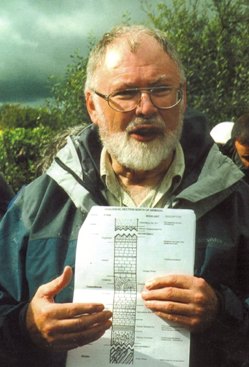Philip Simon Doughty 1937 2013
 Distinguished geologist, museologist and trenchant communicator of science
Distinguished geologist, museologist and trenchant communicator of science
Philip Simon Doughty was a geologist and museologist of distinction. He graduated in Geology and completed a Master’s degree at Nottingham University. While writing his dissertation on Joint directions in the Great Scar Limestone, he married Janet and taught in Keighley.
After a period at Scunthorpe Museum, in 1965 he joined the Ulster Museum’s Department of Natural History in Belfast. As the first geology curator, it was an exciting time to be at the Museum. Phil’s priority was to rescue the existing geology collections from the effects of decades of neglect.
In 1970 the Museum established a new Department of Geology, with Phil as Keeper. Through the 1970s, innovative and award-winning geology galleries were opened and remained popular with visitors for three decades. The geology collections were developed by astute purchases and systematic field collecting. The Museum’s research reputation was enhanced by collaborative projects such as the Bovedy meteorite in 1969, the 1972 Pollnagollum cave excavations in Fermanagh, and the 1986 Aghnadarragh mammoth discoveries near Lough Neagh.
MISSION
Phil’s personal mission to raise the profile of geology, geology collections and museums took him beyond Northern Ireland. He was prominent in the Museum Assistants Group and helped to found the Geological Curators’ Group in 1974. After his ground-breaking survey of museums (The State and Status of Geology in UK Museums, GCG 1981), he served as GCG chairman in the mid-1980s and was awarded its Brighton Medal in 2010. As a Council member of the Museums Association, he became involved with their Information Retrieval Group and helped to pioneer new methods of managing information about museum objects in the 1970s and 1980s.
Phil was a master communicator. This talent was evident in his many radio and TV broadcasts, and in his writings – most notably his words to UNESCO which helped the Giant’s Causeway to achieve World Heritage Site status in 1986. The Dinosaurs Alive! exhibition in 1992 brought giant, robotic dinosaurs to Ireland for the first time – attracting nearly 200,000 paying visitors to the normally free-admission Ulster Museum.
His love of fieldwork meant that site conservation and interpretation were constant career threads. He was a founder and chairman of the Geological Society’s GeoConservation Commission. In retirement, he wrote hundreds of ‘plain-language’ site summaries for Northern Ireland’s Earth Science Conservation Review (www.habitas.org.uk/escr).
HOLISTIC
Phil had a holistic understanding of the natural world. From the early 1990s, by then Head of the Museum’s Sciences Division, he helped to nurture an infant environmental records centre that later became Northern Ireland’s Centre for Environmental Data and Recording. He was a member of the Northern Ireland Biodiversity Group which, in 2002, published the national Biodiversity Strategy.
He also supported the work of local and regional voluntary groups, such as the Belfast Geologists’ Society, the Belfast Naturalists’ Field Club and Earth Science Ireland – all three of which he led as president or chairman at different times.
Phil was born in Wombwell, Yorkshire on 5 March 1937, died in Belfast on 14 January 2013 and is survived by three children, James, Sarah and Peter.
By Peter Crowther